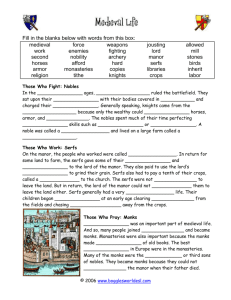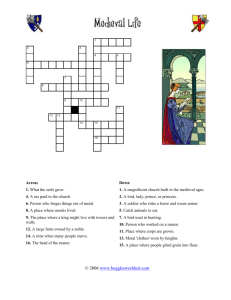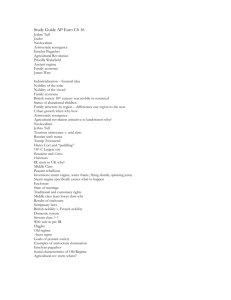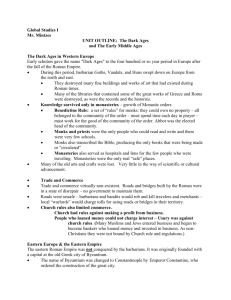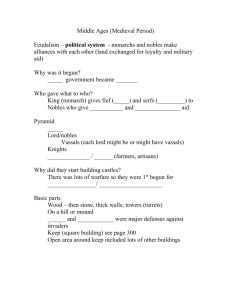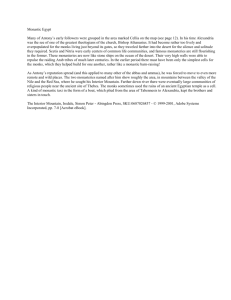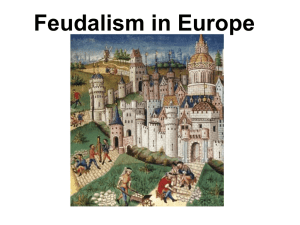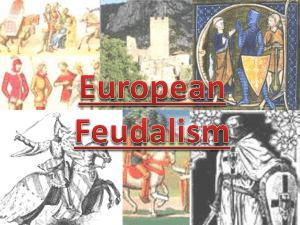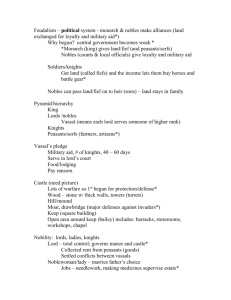Chapter 10: Life in Christian Europe in the High Middle Ages
advertisement
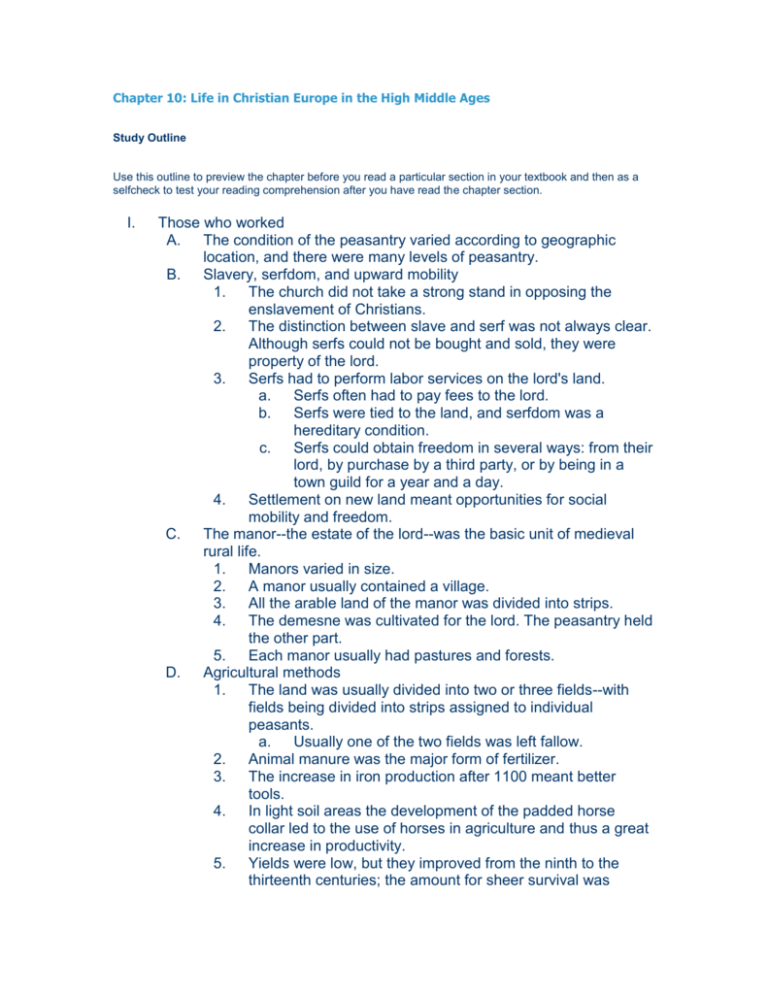
Chapter 10: Life in Christian Europe in the High Middle Ages Study Outline Use this outline to preview the chapter before you read a particular section in your textbook and then as a selfcheck to test your reading comprehension after you have read the chapter section. I. Those who worked A. The condition of the peasantry varied according to geographic location, and there were many levels of peasantry. B. Slavery, serfdom, and upward mobility 1. The church did not take a strong stand in opposing the enslavement of Christians. 2. The distinction between slave and serf was not always clear. Although serfs could not be bought and sold, they were property of the lord. 3. Serfs had to perform labor services on the lord's land. a. Serfs often had to pay fees to the lord. b. Serfs were tied to the land, and serfdom was a hereditary condition. c. Serfs could obtain freedom in several ways: from their lord, by purchase by a third party, or by being in a town guild for a year and a day. 4. Settlement on new land meant opportunities for social mobility and freedom. C. The manor--the estate of the lord--was the basic unit of medieval rural life. 1. Manors varied in size. 2. A manor usually contained a village. 3. All the arable land of the manor was divided into strips. 4. The demesne was cultivated for the lord. The peasantry held the other part. 5. Each manor usually had pastures and forests. D. Agricultural methods 1. The land was usually divided into two or three fields--with fields being divided into strips assigned to individual peasants. a. Usually one of the two fields was left fallow. 2. Animal manure was the major form of fertilizer. 3. The increase in iron production after 1100 meant better tools. 4. In light soil areas the development of the padded horse collar led to the use of horses in agriculture and thus a great increase in productivity. 5. Yields were low, but they improved from the ninth to the thirteenth centuries; the amount for sheer survival was E. F. G. thought to be three times the amount sown--the average thirteenth century manor got a 5 to 1 yield. Life on the manor 1. Medieval village life was provincial and dull but secure. 2. Most peasant households consisted of a nuclear family. 3. Women worked the fields, managed the household, and dominated in the production of beer and ale. 4. Diet included vegetables, some fruit, grains, beer, cheese, some fish, and wild meat--with possibly a great increase in meat consumption by the midthirteenth century--but the mainstay was bread. 5. Children helped with the family chores. Health care 1. People who survived to adulthood were generally strong and tough. 2. Midwives were non-professionals who occasionally performed Cesarean births. 3. Hospitals were established in the twelfth century. 4. Urban people had greater access to doctors--who were usually men. Popular religion 1. The Christian religion infused and regulated daily life. 2. Religious ritual and practice synthesized many elements-Jewish, pagan, Roman, and Christian. 3. The church was the center of village social, political, and economic life. 4. Popular religion consisted largely of symbolic rituals and ceremonies. a. In the twelfth century a sacramental system of religion emerged--under the control of the priest who alone could deliver the seven sacraments b. The sacraments were baptism, penance, eucharist, confirmation, matrimony, orders, and extreme unction. c. The sacraments were believed to bring grace and salvation 5. In the eleventh century a great emphasis on the devotion to Mary evolved. 6. Peasants believed that God intervened directly in human affairs, and that sin was caused by the Devil. 7. Few peasants lived beyond the age of forty; pilgrimages offered adventure and hope in a world of gloom. a. The church granted indulgences (remissions of penalties for sin) to those who visited the shrines of great saints. b. Indulgences and pilgrimages came to be equated with salvation. II. Those who fight A. The nobility strongly influenced all aspects of medieval culture. 1. The social structure of Europe varied from region to region; overall the nobility was an elite, selfconscious social class. a. Nobles held political power and had a special legal status. 2. Nobles were professional fighters. a. Their function was to protect the weak, the poor, and the churches. b. Nobles were supposed to display the chivalric virtues of courage, courtesy, loyalty, generosity, and graciousness. 3. The medieval nobility developed independently of knighthood--all nobles were knights, but not all knights were noble. a. In France and England, the term knight connoted moral values, consciousness of family, and participation in a superior hereditary caste. b. In Germany, a large class of non-noble knights, or ministerials, existed. 4. The nobility regarded peasants in a contradictory manner-usually with contempt, as stupid, and condemned to labor by God, or, at other times, as virtuous and beloved by God. B. Infancy and childhood in aristocratic families 1. Ignorant medical care contributed to the high infant mortality rate. 2. Infanticide probably decreased during this period, but abandonment of infants, which was socially acceptable, increased. 3. Children were often sold or given to monasteries as oblates. 4. Other familyplanning strategies, such as primogeniture, late marriages, and birth control, were used to preserve family estates. 5. Most young aristocratic children had a great deal of playtime and freedom. 6. At about age seven, aristocratic boys served in a lord's household and received formal training in arms. a. Learning to read and write was not common until the eleventh and twelfth centuries. b. Formal training concluded at age twentyone with the ceremony of knighthood. C. Youth in aristocratic families 1. Unless a young man's father was dead, he was still considered a youth and could not marry. 2. III. Knighted men whose fathers were alive had to find activities, such as travel, tournaments, and carousing, to occupy themselves. 3. Aristocratic women married early; their families provided large marriage portions, or dowries. 4. Generational disputes were common in aristocratic families in the twelfth and thirteenth centuries. 5. Sexual tensions arose from aristocratic marriage practices, which brought together young wives, older husbands, and young, unmarried men. D. Power and responsibility in the aristocracy 1. A male member of the nobility became an adult when he came into possession of his property. 2. Aristocrats saw lavish living as a sign of status and power, but it often meant debt. 3. As a vassal, a noble was required to fight for the lord or for the king when called on to do so. 4. He was also obliged to attend his lord's court on important occasions. 5. He had to look after his own estates, which usually required frequent travel. 6. Holding the manorial court was one of his major duties. 7. Women played an important role in running the estate--partly because men were frequently away. a. Because of frequent warfare, many women became widows, and thus came to control land and exercise great authority. 8. All in all, the constant warfare among the nobility was a constant source of trouble for the monarchy--causing the monarchy to turn to the middle classes for support; the Crusades eliminated some the most dangerous problems for the monarchs. Those who pray A. Prayer was a vital social service performed by monks; they also performed other important cultural and economic services. B. Recruitment 1. Many who became monks did so because of their parents' decision to give them to the church as oblates. 2. Monasteries provided careers for aristocratic children. 3. In the later Middle Ages the monasteries recruited from the middle class. C. The nuns 1. Convents were established for women of the noble class. a. The abbess or prioress was customarily a woman of high social standing. b. Some abbesses achieved national prominence. 2. D. E. The duties of a nun varied from religious duties, to administration, to sewing and perhaps manuscript copying. a. Hildegard of Bingen represents the scholarly life of many nuns. b. Isabella of Lancaster represents the type of prioress who was active in court life and travel. Prayer and other work 1. Daily life in the monasteries centered on the liturgy. a. The need to praise God justified the spending of a great deal of money on objects to enhance the liturgy. b. The liturgy thus inspired a great deal of art. 2. Aristocratic monks, or choir monks, did not till the land, but relied on lay brothers supervised by a cellarer for this. 3. The almoner took care of the poor; and the novice master, the training of recruits. 4. Law and medicine were studied and practiced--sometimes in the royal court. 5. Raising and breeding of horses were undertaken, as was the conversion of wasteland to agriculture. 6. The Cistercians were important in agricultural developments in the Low Countries, Germany, France, and England. 7. Some monasteries got involved in iron and lead mining. 8. Most monasteries were involved in providing social services such as schools, hospitals, and hostels for travelers. Economic difficulties 1. By the late Middle Ages many monasteries, such as Cluny, did not have enough income to support their lavish lifestyle. 2. Many fell into debt and agricultural recession led to less endowment.
